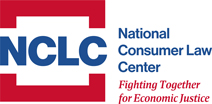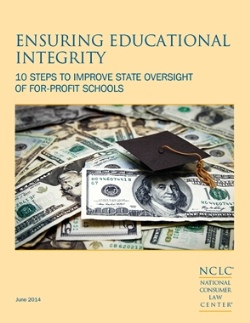10 Steps to Improve State Oversight of For-Profit Schools
Increasing numbers of state and federal investigations have revealed the widespread use of deceptive and illegal practices throughout the for-profit higher education sector, including by large accredited schools owned by Wall Street investors. Hundreds of thousands of students enrolled in inferior educational programs and ended up with nothing but debt. This NCLC report focuses on how states can do a better job to rein in these abuses and protect students.
Updates:
Step 2: Protecting Online Education Students, Dec. 2015
Report
Executive Summary
Charts and Tables
Government Investigations/Lawsuits of For-Profit Schools (2004 – May 2014)
Toolkit for Increasing Effective Oversight
In Their Own Words: For-Profit Student Stories
Press Release
Related Publications
Student Loan Law
Surviving Debt
This report builds on NCLC’s advocacy, training, publications, and public policy work on for-profit schools and higher education issues to promote family financial well-being. Learn more about NCLC’s work.
Key Findings
When the federal government recently enacted state authorization regulations, it reemphasized that states are primarily responsible for school oversight and student protection. Few states, however, have responded by strengthening their for-profit school oversight statutes and agencies. Instead, since the publication of NCLC’s 2011 report, State Inaction: Gaps in State Oversight of For-Profit Education, most states continue to neglect their critical oversight and consumer protection role.
Recommendations
This report includes ten key recommendations that states may use to develop stronger for-profit school oversight laws and agencies. If implemented, these changes will significantly help prevent abuses and make the for-profit higher education more accountable to states, students, and taxpayers.
1. Eliminate reliance on accreditation as a substitute for oversight and require all accredited and unaccredited schools to comply with minimum standards and consumer protections.
![]() Over half the states apply lenient standards or grant some type of exemption or automatic approval to accredited for-profit schools, yet 61 of the government investigations and lawsuits summarized in Appendix A of the report involve accredited schools.
Over half the states apply lenient standards or grant some type of exemption or automatic approval to accredited for-profit schools, yet 61 of the government investigations and lawsuits summarized in Appendix A of the report involve accredited schools.
![]() Accredited schools are the only schools eligible for federal financial aid and therefore tend to cause the greatest financial harm to the largest number of students.
Accredited schools are the only schools eligible for federal financial aid and therefore tend to cause the greatest financial harm to the largest number of students.
![]() All unaccredited and accredited schools should be subjected to rigorous minimum standards and consumer protection requirements.
All unaccredited and accredited schools should be subjected to rigorous minimum standards and consumer protection requirements.
2. Increase oversight of schools exclusively offering online/distance educationprograms.
![]() Distance education is the fastest growing segment of higher education.
Distance education is the fastest growing segment of higher education.
![]() States have not kept up with this trend: many do not regulate any segment of for-profit schools exclusively offering distance education, making expanding oversight laws to include these for-profit schools a priority.
States have not kept up with this trend: many do not regulate any segment of for-profit schools exclusively offering distance education, making expanding oversight laws to include these for-profit schools a priority.
![]() Although existing state authorization reciprocity agreements (SARAs) provide weak standards and few consumer protections, 17 states have already passed laws authorizing their state agencies to join and 7 have already joined.
Although existing state authorization reciprocity agreements (SARAs) provide weak standards and few consumer protections, 17 states have already passed laws authorizing their state agencies to join and 7 have already joined.
![]() Before signing onto SARAs, states should demand that they allow states to apply their own consumer protections to distance education schools.
Before signing onto SARAs, states should demand that they allow states to apply their own consumer protections to distance education schools.
3. Establish and enforce meaningful minimum performance standards as requirements for state approval.
![]() For-profit schools often manipulate and inflate completion and job placement rates. To protect students from low-quality and deceptive for-profit schools, states should require them to maintain minimum completion and job placement rates as a condition of state approval.
For-profit schools often manipulate and inflate completion and job placement rates. To protect students from low-quality and deceptive for-profit schools, states should require them to maintain minimum completion and job placement rates as a condition of state approval.
![]() State law should also clearly define these rates and mandate that the oversight agency implement a program for auditing them.
State law should also clearly define these rates and mandate that the oversight agency implement a program for auditing them.
4. Focus increased supervisory and enforcement resources on for-profit schools at risk of deceiving students.
![]() Many state oversight agencies lack sufficient funding to regulate for-profit schools effectively.
Many state oversight agencies lack sufficient funding to regulate for-profit schools effectively.
![]() Although increasing agency funds is one solution, agencies should also focus their limited resources on for-profit schools that are most likely to harm students.
Although increasing agency funds is one solution, agencies should also focus their limited resources on for-profit schools that are most likely to harm students.
![]() State agencies should develop specific criteria and procedures for identifying and investigating schools that may be engaging in systemic legal violations (see page 66 of report).
State agencies should develop specific criteria and procedures for identifying and investigating schools that may be engaging in systemic legal violations (see page 66 of report).
5. Require a fair and thorough process for investigating and resolving student complaints.
![]() Students who are harmed by for-profit schools have few ways to seek relief, so schools rarely face consequences for illegal practices.
Students who are harmed by for-profit schools have few ways to seek relief, so schools rarely face consequences for illegal practices.
![]() It is critical that state law require the oversight agency to accept, investigate, and resolve student complaints.
It is critical that state law require the oversight agency to accept, investigate, and resolve student complaints.
![]() To ensure it has sufficient investigative resources, states should also require the agency to expend at least 60% of its budget on investigation and enforcement (see p. 67 of report).
To ensure it has sufficient investigative resources, states should also require the agency to expend at least 60% of its budget on investigation and enforcement (see p. 67 of report).
6. Establish an independent oversight board to increase public accountability.
![]() Because a public board is in a position to constantly pressure an agency’s staff to perform its statutory obligations, the creation of a board may lead to a more effective oversight agency as long as it is not dominated by school representatives.
Because a public board is in a position to constantly pressure an agency’s staff to perform its statutory obligations, the creation of a board may lead to a more effective oversight agency as long as it is not dominated by school representatives.
7. Prohibit domination of the oversight board by the for-profit school industry.
![]() State boards dominated by educational institutions can seriously undermine the work of oversight agencies.
State boards dominated by educational institutions can seriously undermine the work of oversight agencies.
![]() States should require a fair mix of school, employer, student, consumer advocate, public, and law enforcement representatives on oversight boards.
States should require a fair mix of school, employer, student, consumer advocate, public, and law enforcement representatives on oversight boards.
![]() States should also prohibit licensed institutions from comprising board majorities, including when vacancies exist.
States should also prohibit licensed institutions from comprising board majorities, including when vacancies exist.
8. Assign responsibility for all for-profit school oversight to one agency with expertise in consumer protection and for-profit business regulation.
![]() Spreading oversight among different agencies weakens the state’s ability to protect students.
Spreading oversight among different agencies weakens the state’s ability to protect students.
![]() A more effective approach is to vest all for-profit school oversight in a single agency with expertise in investigative procedures and consumer protection, as well as higher education.
A more effective approach is to vest all for-profit school oversight in a single agency with expertise in investigative procedures and consumer protection, as well as higher education.
9. Provide a clear mandate that the state agency’s primary duty is ensuring educational quality and consumer protection.
10. Eliminate sunset provisions in for-profit school oversight statutes.
![]() Sunset provisions, which provide for the automatic termination of a statute and oversight agency on a set date unless extended by the state legislature, give the for-profit industry an opportunity to either water down standards or prevent the extension of a state law and agency.
Sunset provisions, which provide for the automatic termination of a statute and oversight agency on a set date unless extended by the state legislature, give the for-profit industry an opportunity to either water down standards or prevent the extension of a state law and agency.
![]() States should eliminate sunset provisions and instead provide for periodic legislative reviews without automatic termination of the statute and agency.
States should eliminate sunset provisions and instead provide for periodic legislative reviews without automatic termination of the statute and agency.
By the Numbers on States & For-Profit Schools
1. From 2004 to May 2014, 27 state attorneys general and 5 federal agencies have brought more than 61 investigations/lawsuits against for-profit higher education schools.
2. Growth of undergraduate enrollment at 4-year degree-granting schools (2000 – 2009)
For-profit 470%
Public 30%
Nonprofit 19%
3. Percentage of for-profit school students who were enrolled in schools that were publicly traded or owned by private equity firms (2009)
76%
4. Percentage of students graduating within 6 years at 4-year schools (2011-2012)
For-profit 32%
Public 57%
Nonprofit 66%
5. Default rates of 4-year colleges within 3 years of repayment (for borrowers entering repayment in 2010)
For-profit 22.8%
Public 13.0%
Nonprofit 8.2%
6. Average student loan debt at graduation of 4-year colleges (2011-2012)
For-profit $39,950
Public $25,550
Nonprofit $32,300
7. Share of for-profit college enrollment at 4-year schools by race (2011 – 2012)
African American 28%
Latino 15%
White 10%
8. Online/distance education is now the fastest growing segment of higher education.
Top for-profit producers of Bachelor’s degrees and % of degrees per race (20011 – 2012)
African American 1. University of Phoenix (4%) 2. Ashford University (2.4%)
Latino 1. Florida Intl. University (4%) 2. Univ. of Phoenix Online (2.0%)
White 1. Univ. of Phoenix Online (2%) 2. Ohio State University (1.0%)

